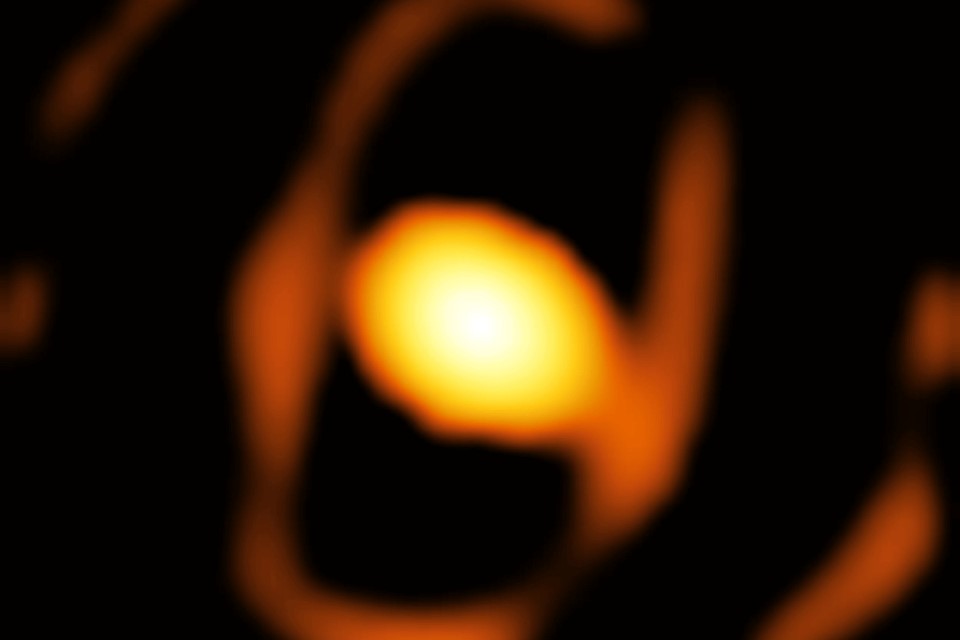Astronomer from Keele helps take the first close-up picture of a dying star outside our galaxy

An international research team, including an astronomer at Keele University, have succeeded for the first time in taking a zoomed-in image of a dying star in a galaxy outside our own Milky Way.
Located a staggering 160,000 light-years from Earth, the star - WOH G64 - was imaged by the European Southern Observatory’s Very Large Telescope Interferometer (ESO's VLTI). The new observations reveal a star puffing out gas and dust, in the last stages before it becomes a supernova.
While astronomers have taken about two dozen zoomed-in images of stars in our galaxy, unveiling their properties, countless other stars dwell within other galaxies, so far away that observing even one of them in detail has been extremely challenging until now.
The newly imaged star lies within the Large Magellanic Cloud, one of the small galaxies that orbits the Milky Way. Astronomers have known about this star for decades and have appropriately dubbed it the 'behemoth star'. With a size roughly 2,000 times that of our Sun, WOH G64 is classified as a red supergiant. In their final life stages, red supergiants like WOH G64 shed their outer layers of gas and dust in a process that can last thousands of years.
Dr Jacco van Loon, Reader in Astrophysics at Keele University and co-author on a study reporting the observations published today in Astronomy & Astrophysics, has been studying WOH G64 since the 1990s.
He said: "Massive stars explode with an energy equivalent to the Sun shining for all of its 10 billion years of life. People have seen these supernova explosions, and astronomers have found some of the stars that exploded in older images. But we have never seen a star change in a way that signals its imminent death.
"One star has caught our eye. Called WOH G64, it is the largest star living in a galaxy only 160,000 light years away. Ever since as a student I discovered radio lasers in the gas in which this star has wrapped itself, I have had a deep fondness for this star. Now, we have taken the first ever picture of it with one of the most powerful telescopes on Earth, and discovered dramatic changes in the star. This star is one of the most extreme of its kind, and any drastic change may bring it closer to a spectacular and explosive end."
For the desired picture, the team had to wait for the development of one of the telescope's second-generation instruments, GRAVITY. After comparing their new results with other previous observations of WOH G64, they were surprised to find that the star had become dimmer over the past decade, providing a rare opportunity to witness a star’s life in real time.
Lead author Keiichi Ohnaka, an astrophysicist from Universidad Andrés Bello in Chile, said: "We discovered an egg-shaped cocoon closely surrounding the star. We are excited because this may be related to the drastic ejection of material from the dying star before a supernova explosion."
Researchers from the Max Planck Institute for Radio Astronomy, Bonn, Germany, and the Space Telescope Science Institute, Baltimore, USA, were also involved in the study.
Most read
- Research by Keele alumnus improves outcomes for children with rare type of brain tumour
- Keele and NHS Trust partner to advance ethical AI in healthcare
- Keele Business School leaders invited to discuss work in Parliament
- Health impacts of eating disorders complex and long-lasting, researchers find
- Keele-led hydrogen research programme scoops top industry award
Contact us
Andy Cain,
Media Relations Manager
+44 1782 733857
Abby Swift,
Senior Communications Officer
+44 1782 734925
Adam Blakeman,
Press Officer
+44 7775 033274
Ashleigh Williams,
Senior Internal Communications Officer
Strategic Communications and Brand news@keele.ac.uk.


